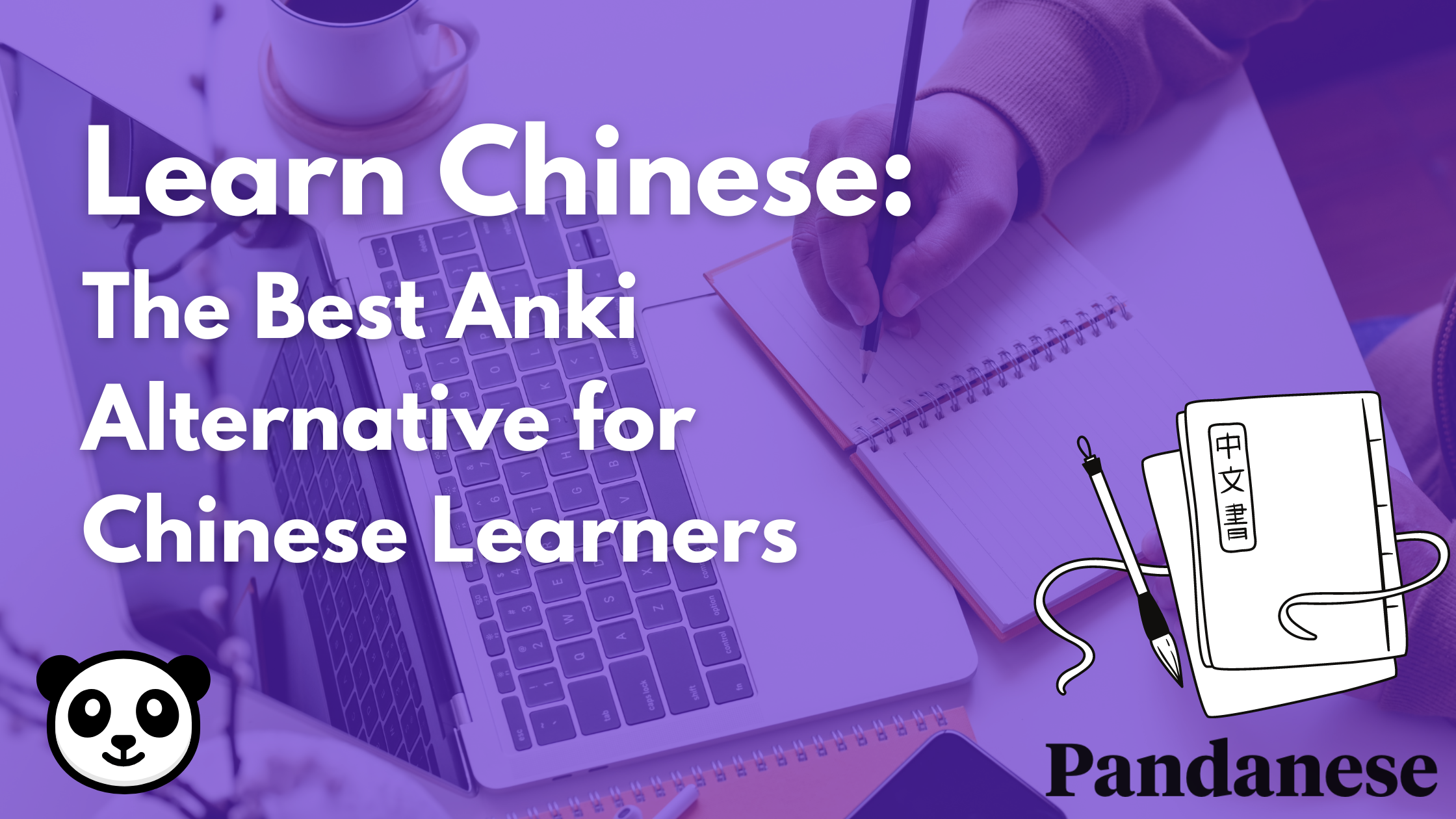
The Best Anki Alternative for Chinese Learners
In the market for the best Anki alternative for Chinese learners? There is no need to search countless threads for the best Chinese Anki alternatives on Reddit, sign up for different Chinese learning platforms, or download multiple Chinese flashcard apps. This article will show you the best alternative flashcard app to learn Chinese.
What is Anki?
Anki is a flashcard app designed to aid in memory retention using the Spaced Repetition System. You search for other users or create your own flashcards.
Even though it was not developed or promoted as a language learning application, many language students use it to learn new vocabulary and grammar because of its effective systems.
It's mainly based on the Spaced Repetition System and Flashcard system.
Anki explanation, Rachel Southard
What is the Spaced Repetition System?
It is a learning strategy that uses strategically planned material review to manipulate the human brain's learning curve. This learning strategy emphasizes steadily growing revision intervals, easily transferring short-term knowledge to long-term memory.
SRS takes advantage of the psychological spacing effect, suggesting that learning is more effective over time than in a single learning session. Perfect for any learning style.
How spaced repetition can help with learning, Osmosis from ElsevierIs SRS good for Chinese learning?
Spaced repetition flashcards are good for learning any language, including Chinese, because it helps you build your vocabulary over time and keep information in your long-term memory. If you somewhat recall a particular word, the SRS will know that you will need to study that word a bit more.
Mandarin is a complex language of thousands and thousands of characters, so by using SRS, you're hacking your memory to retain this large amount of information.
Learning Chinese characters with and without SRS, Steve Kaufmann - lingosteveHow do flashcards help in learning Chinese?
There are many different learning modes, but flashcards are a part of language learning and vocabulary-building.
Using flashcards is an effective way to exercise your brain and fix concepts in your memory. It is also a great tool for reviewing what you have already learned.
The 5 principles on how to use flashcards for language learning, The Language Scientist
Anki is definitely a useful tool in language learning, but wouldn't it be great to use a program specifically designed for learning Chinese? Unlike Anki, Pandanese was specifically designed as a Mandarin learning platform: no need to spend hours creating your own flashcard decks and hack your way around the program.
Enter in Pandanese.
The Anki Alternative for Chinese Learners – Pandanese
What is Pandanese?
Meet Pandanese—an exciting development on the flashcard apps scene for Chinese learners concerned with ease of use, reliability, and certified content.
It is an easy way to learn Chinese and build vocabulary. It employs the same system that Chinese learners love about Anki: you will find the spaced repetition feature and flashcards mode. For this reason, it is a great alternative.

Infographic of Pandanese vs Anki
Anki vs. Pandanese: A side-by-side comparison
In this article, we provide a deep dive into our Anki vs. Pandanese comparison–-and find the best overall flashcard alternative for Chinese language learning for you!
Pandanese and Anki offer a comparable collaborative learning experience by enabling users to break down enormous amounts of material into groups of specific facts that can be further examined in a question-and-answer manner. The two platforms then use the spaced repetition algorithm to encourage students to review what they learned after taking a break so that it is deeply embedded in their long-term memory.
Pandanese and Anki operate under the same fundamental principle. They help users retain information more effectively using tried-and-true cognitive learning concepts such as active recall, spaced repetition, and metacognition.
To help you better visualize the differences between the two platforms, we've made this handy side-by-side comparison chart for you:
|
Anki |
Pandanese |
|---|---|---|
Platform |
Must download Anki to learn with flashcards Anki is available on Windows, Linux, iOS, MacOs, and Android. |
Web-based Chinese learning platform. Users can sign up or log in to learn anytime, from anywhere. |
Learning Category |
Supports learning in a wide range of topics and can be customized to aid in memory retention of different topics. |
Designed for Chinese learning. It is optimized to help Chinese learners with radicals, characters, and vocabulary, organized into 60 lessons (with subscription) |
Content |
Anki only uses User Generated Content (UGC) for their Chinese Anki Decks. |
Offers hand-crafted curriculums by language experts designed for particular learning purposes: business, school, and travel. |
Trustworthiness |
UGC isn’t organized based on quality, accuracy, and thoroughness, so you don’t know if you can trust what you find. |
Pandanese’s language experts work closely to ensure the lesson content is useful, accurate, and reliable. |
User Experience |
Runs with open source and is not optimized by user experience (UX) designers. Some say it’s hard to use. |
Has a beautiful and simple user interface with a consistent UI/UX experience. |
Workload |
The UGC can fall short of your learning needs, so you need to make your own custom flashcards from scratch which requires a lot of work. |
Each lesson contains specific content according to the student’s learning purpose. In each lesson, users will be given a batch of flashcards. After learning, they will take a quick quiz to remember what they’ve just learned. |
Spaced Repetition System |
Requires scheduling and discipline and can be quite prescriptive about when you can study. |
The neuroscience-based SRS algorithm prompts you to review radicals, characters, and vocabulary at specific times to maximize retention. |
Language Learning Aid |
You can find hacks and tutorials to make Anki work for you in learning Chinese to build vocabulary and aid learning. |
Pandanese helps you build vocabulary by teaching you the basics. Pandanese teaches radicals, characters, and then vocabulary instead of individual strokes. Pandanese also uses Mnemonics to aid in memorization and to make learning fun! |
Cost |
Anki is completely free, but you have to put in the work to make it useful for your Chinese learning. You pay for it with your time and effort. |
Pandanese’s subscription fee starts at a low price of $9 per month to $299 for lifetime use. |
Side-By-Side Comparison: Anki Vs. Pandanese
Is Pandanese better than Anki?
We found that Pandanese has a cleaner, more user-friendly experience compared to the Anki flashcards app or other apps.
But the winning, fundamental differences between Pandanese and Anki are in curriculum creation, curation, trustworthiness (certified language experts created well-organized flashcards), and delivery.
The pros to using Pandanese for Hanzi learning
Flexibility
A web-based language learning platform means you can access the website, log in to your account, and learn from anywhere, at any time. Pandanese is the perfect Anki alternative for Hanzi when you are on the go or have some free time.
A beautiful user experience
Pandanese has a beautiful, intuitive interface with a consistent and optimized user experience.
Easy to curate and organize knowledge
Pandanese fundamentally makes it much easier for users to organize their knowledge by dividing flashcards into categories (Radical, Character, Vocabulary) and categories into lessons. Each lesson contains a particular number of Radical, Character, and Vocabulary flashcards so that users can always keep track of what they have learned, how many flashcards they will learn next, and so on.
When learning with Pandanese, you can see exactly how many Radical, Character, or Vocabulary flashcards you will learn in each lesson.
Trusted and certified content
Pandanese works closely with language experts to create certified flashcard lessons comprehensive for a particular learning purpose (business, travel, or school). However, Anki has no certified content, only user-generated content (UGC), which isn't 100% accurate or trustable. You have no idea what you're getting when accessing other users' flashcards.
Designed for Chinese learning
Pandanese is not just a flashcard program that employs SRS. It is so much more than that.
Its curriculum was hand-crafted by language experts to aid in the gentle progression to learning Chinese. It also equips students with the basics, which serve as building blocks in their Chinese learning journey.
Students familiarize themselves with radicals, characters, and vocabulary instead of individual strokes. Mnemonics techniques give students playful elements and tools to make learning fun and aid memorization.
The verdict: Pandanese–the best Anki alternative for Chinese learners
For Anki users looking for an alternative or those simply looking for tailored hanzi flashcards, Pandanese has a great app you can use for learning Chinese. Why not maximize your language-learning efforts from the get-go?
Pandanese is a desktop version designed specifically with Chinese learners in mind. There is
No hassle of making your flashcards
No more wondering if the answers are correct
No hacking the system to make it work
Pandanese does all the work for you! You can test out Pandanese's basic features by looking at the free version, but I recommend you upgrade to the premium version to unlock advanced features and get the best out of this platform.
What about you? What app do you consider the perfect Anki alternative for Chinese learners?
The easiest way to learn Chinese & build vocabulary

